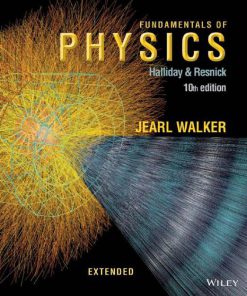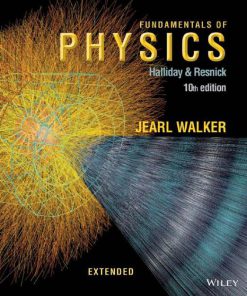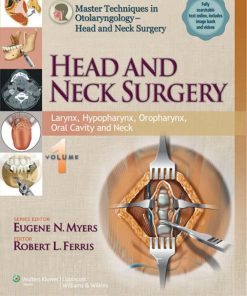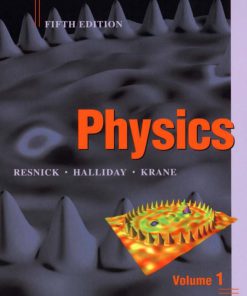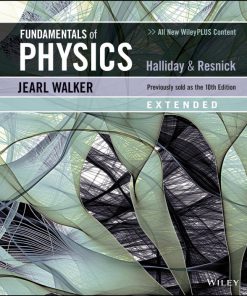Physics Volume 1 5th Edition by Robert Resnick,David Halliday,Kenneth Krane 9781119076971 1119076978
$50.00 Original price was: $50.00.$25.00Current price is: $25.00.
Authors:Robert Resnick (2002) , Series:Physics [4] , Tags:Science ; Physics; General , Author sort:Resnick, Robert , Languages:Languages:eng , Published:Published:Sep 2014 , Publisher:Wiley , Comments:Comments:For customer technical support, please visit http://www.wileyplus.com/support. WileyPLUS registration cards are only included with new products. Used and rental products may not include WileyPLUS registration cards.Written for the full year or three term Calculus-based University Physics course for science and engineering majors, the publication of the first edition of Physics in 1960 launched the modern era of Physics textbooks. It was a new paradigm at the time and continues to be the dominant model for all texts. Physics is the most realistic option for schools looking to teach a more demanding course.
Physics Volume 1 5th Edition by Robert Resnick,David Halliday,Kenneth Krane – Ebook PDF Instant Download/Delivery.9781119076971,1119076978
Full download Physics Volume 1 5th Edition after payment
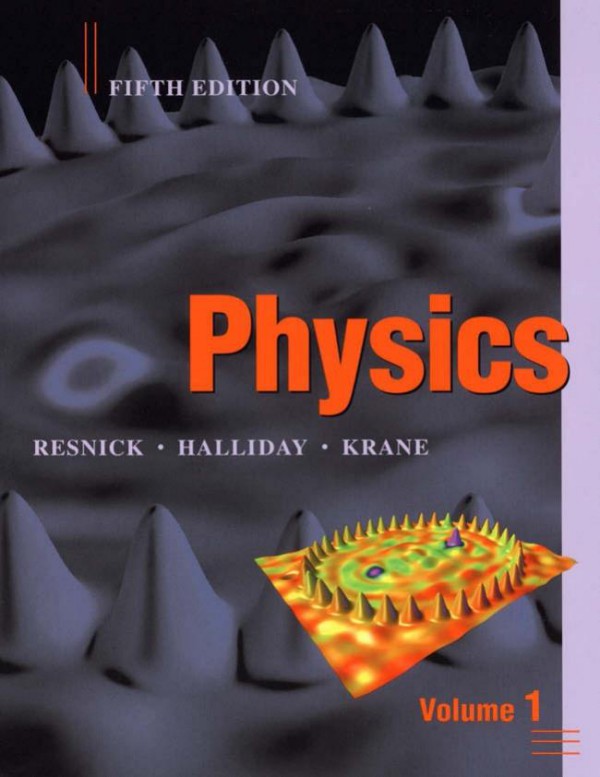
Product details:
ISBN 10:1119076978
ISBN 13:9781119076971
Author:Robert Resnick,David Halliday,Kenneth Krane
Written for the full year or three term Calculus-based University Physics course for science and engineering majors, the publication of the first edition of Physics in 1960 launched the modern era of Physics textbooks. It was a new paradigm at the time and continues to be the dominant model for all texts. Physics is the most realistic option for schools looking to teach a more demanding course.
Physics Volume 1 5th Table of contents:
CHAPTER 1 MEASUREMENT
1-1 Physical Quantities, Standards, and Units
1-2 The International System of Units
1-3 The Standard of Time
1-4 The Standard of Length
1-5 The Standard of Mass
1-6 Precision and Significant Figures
1-7 Dimensional Analysis
Questions and Problems
CHAPTER 2 MOTION IN ONE DIMENSION
2-1 Kinematics with Vectors
2-2 Properties of Vectors
2-3 Position, Velocity, and Acceleration Vectors
2-4 One-Dimensional Kinematics
2-5 Motion with Constant Acceleration
2-6 Freely Falling Bodies
Questions and Problems
CHAPTER 3 FORCE AND NEWTON’S LAWS
3-1 Classical Mechanics
3-2 Newton’s First Law
3-3 Force
3-4 Mass
3-5 Newton’s Second Law
3-6 Newton’s Third Law
3-7 Weight and Mass
3-8 Applications of Newton’s Laws in One Dimension
Questions and Problems
CHAPTER 4 MOTION IN TWO AND THREE DIMENSIONS
4-1 Motion in Three Dimensions with Constant Acceleration
4-2 Newton’s Laws in Three-Dimensional Vector Form
4-3 Projectile Motion
4-4 Drag Forces and the Motion of Projectiles (Optional)
4-5 Uniform Circular Motion
4-6 Relative Motion
Questions and Problems
CHAPTER 5 APPLICATIONS OF NEWTON’S LAWS
5-1 Force Laws
5-2 Tension and Normal Forces
5-3 Frictional Forces
5-4 The Dynamics of Uniform Circular Motion
5-5 Time-Dependent Forces (Optional)
5-6 Noninertial Frames and Pseudoforces (Optional)
5-7 Limitations of Newton’s Laws (Optional)
Questions and Problems
CHAPTER 6 MOMENTUM
6-1 Collisions
6-2 Linear Momentum
6-3 Impulse and Momentum
6-4 Conservation of Momentum
6-5 Two-Body Collisions
Questions and Problems
CHAPTER 7 SYSTEMS OF PARTICLES
7-1 The Motion of a Complex Object
7-2 Two-Particle Systems
7-3 Many-Particle Systems
7-4 Center of Mass of Solid Objects
7-5 Conservation of Momentum in a System of Particles
7-6 Systems of Variable Mass (Optional)
Questions and Problems
CHAPTER 8 ROTATIONAL KINEMATICS
8-1 Rotational Motion
8-2 The Rotational Variables
8-3 Rotational Quantities as Vectors
8-4 Rotation with Constant Angular Acceleration
8-5 Relationships Between Linear and Angular Variables
8-6 Vector Relationships Between Linear and Angular Variables (Optional)
Questions and Problems
CHAPTER 9 ROTATIONAL DYNAMICS
9-1 Torque
9-2 Rotational Inertia and Newton’s Second Law
9-3 Rotational Inertia of Solid Bodies
9-4 Torque Due to Gravity
9-5 Equilibrium Applications of Newton’s Laws for Rotation
9-6 Nonequilibrium Applications of Newton’s Laws for Rotation
9-7 Combined Rotational and Translational Motion
Questions and Problems
CHAPTER 10 ANGULAR MOMENTUM
10-1 Angular Momentum of a Particle
10-2 Systems of Particles
10-3 Angular Momentum and Angular Velocity
10-4 Conservation of Angular Momentum
10-5 The Spinning Top
10-6 Review of Rotational Dynamics
Questions and Problems
CHAPTER 11 ENERGY 1: WORK AND KINETIC ENERGY
11-1 Work and Energy
11-2 Work Done by a Constant Force
11-3 Power
11-4 Work Done by a Variable Force
11-5 Work Done by a Variable Force: Two-Dimensional Case (Optional)
11-6 Kinetic Energy and the Work-Energy Theorem
11-7 Work and Kinetic Energy in Rotational Motion
11-8 Kinetic Energy in Collisions
Questions and Problems
CHAPTER 12 ENERGY 2: POTENTIAL ENERGY
12-1 Conservative Forces
12-2 Potential Energy
12-3 Conservation of Mechanical Energy
12-4 Energy Conservation in Rotational Motion
12-5 One-Dimensional Conservative Systems: The Complete Solution
12-6 Three-Dimensional Conservative Systems (Optional)
Questions and Problems
CHAPTER 13 ENERGY 3: CONSERVATION OF ENERGY
13-1 Work Done on a System by External Forces
13-2 Internal Energy in a System of Particles
13-3 Frictional Work
13-4 Conservation of Energy in a System of Particles
13-5 Center-of-Mass Energy
13-6 Reactions and Decays
13-7 Energy Transfer by Heat
Questions and Problems
CHAPTER 14 GRAVITATION
14-1 Origin of the Law of Gravitation
14-2 Newton’s Law of Universal Gravitation
14-3 The Gravitational Constant G
14-4 Gravitation Near the Earth’s Surface
14-5 The Two Shell Theorems
14-6 Gravitational Potential Energy
14-7 The Motions of Planets and Satellites
14-8 The Gravitational Field (Optional)
14-9 Modern Developments in Gravitation (Optional)
Questions and Problems
CHAPTER 15 FLUID STATICS
15-1 Fluids and Solids
15-2 Pressure and Density
15-3 Variation of Pressure in a Fluid at Rest
15-4 Pascal’s Principle and Archimedes’ Principle
15-5 Measurement of Pressure
15-6 Surface Tension (Optional)
Questions and Problems
CHAPTER 16 FLUID DYNAMICS
16-1 General Concepts of Fluid Flow
16-2 Streamlines and the Equation of Continuity
16-3 Bernoulli’s Equation
16-4 Applications of Bernoulli’s Equation and the Equation of Continuity
16-5 Fields of Flow (Optional)
16-6 Viscosity, Turbulence, and Chaotic Flow (Optional)
Questions and Problems
CHAPTER 17 OSCILLATIONS
17-1 Oscillating Systems
17-2 The Simple Harmonic Oscillator
17-3 Simple Harmonic Motion
17-4 Energy in Simple Harmonic Motion
17-5 Applications of Simple Harmonic Motion
17-6 Simple Harmonic Motion and Uniform Circular Motion
17-7 Damped Harmonic Motion
17-8 Forced Oscillations and Resonance
17-9 Two-Body Oscillations (Optional)
Questions and Problems
CHAPTER 18 WAVE MOTION
18-1 Mechanical Waves
18-2 Types of Waves
18-3 Traveling Waves
18-4 Wave Speed on a Stretched String
18-5 The Wave Equation (Optional)
18-6 Energy in Wave Motion
18-7 The Principle of Superposition
18-8 Interference of Waves
18-9 Standing Waves
18-10 Standing Waves and Resonance
Questions and Problems
CHAPTER 19 SOUND WAVES
19-1 Properties of Sound Waves
19-2 Traveling Sound Waves
19-3 The Speed of Sound
19-4 Power and Intensity of Sound Waves
19-5 Interference of Sound Waves
19-6 Standing Longitudinal Waves
19-7 Vibrating Systems and Sources of Sound
19-8 Beats
19-9 The Doppler Effect
Questions and Problems
CHAPTER 20 THE SPECIAL THEORY OF RELATIVITY
20-1 Troubles with Classical Physics
20-2 The Postulates of Special Relativity
20-3 Consequences of Einstein’s Postulates
20-4 The Lorentz Transformation
20-5 Measuring the Space-Time Coordinates of an Event
20-6 The Transformation of Velocities
20-7 Consequences of the Lorentz Transformation
20-8 Relativistic Momentum
20-9 Relativistic Energy
20-10 The Common Sense of Special Relativity
Questions and Problems
CHAPTER 21 TEMPERATURE
21-1 Temperature and Thermal Equilibrium
21-2 Temperature Scales
21-3 Measuring Temperatures
21-4 Thermal Expansion
21-5 The Ideal Gas
Questions and Problems
CHAPTER 22 MOLECULAR PROPERTIES OF GASES
22-1 The Atomic Nature of Matter
22-2 A Molecular View of Pressure
22-3 The Mean Free Path
22-4 The Distribution of Molecular Speeds
22-5 The Distribution of Molecular Energies
22-6 Equations of State for Real Gases
22-7 The Intermolecular Forces (Optional)
Questions and Problems
CHAPTER 23 THE FIRST LAW OF THERMODYNAMICS
23-1 Heat: Energy in Transit
23-2 The Transfer of Heat
23-3 The First Law of Thermodynamics
23-4 Heat Capacity and Specific Heat
23-5 Work Done on or by an Ideal Gas
23-6 The Internal Energy of an Ideal Gas
23-7 Heat Capacities of an Ideal Gas
23-8 Applications of the First Law of Thermodynamics
Questions and Problems
CHAPTER 24 ENTROPY AND THE SECOND LAW OF THERMODYNAMICS
24-1 One-Way Processes
24-2 Defining Entropy Change
24-3 Entropy Change for Irreversible Processes
24-4 The Second Law of Thermodynamics
24-5 Entropy and the Performance of Engines
24-6 Entropy and the Performance of Refrigerators
24-7 The Efficiencies of Real Engines
24-8 The Second Law Revisited
24-9 A Statistical View of Entropy
Questions and Problems
APPENDICES
A. The International System of Units (SI)
B. Fundamental Physical Constants
C. Astronomical Data
D. Properties of the Elements
E. Periodic Table of the Elements
F. Elementary Particles
G. Conversion Factors
H. Vectors
I. Mathematical Formulas
J. Nobel Prizes in Physics
ANSWERS TO ODD-NUMBERED PROBLEMS
PHOTO CREDITS
People also search for Physics Volume 1 5th:
resnick halliday physics volume 1 pdf
concepts of physics volume 1
physics volume 1 and 2
physics volume 1 answers
physics book 1 and 2
You may also like…
eBook PDF
Electrical Craft Principles Volume 1 5th Edition by John Whitfield 0863419321 978-0863419324
eBook PDF
Physics Volume 1 5th Edition by Robert Resnick,David Halliday,Kenneth Krane 9781119076971 1119076978





